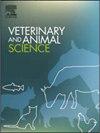Spatiotemporal cluster analysis and predicting lumpy skin disease outbreaks in cattle in selected zones of Oromia region, Ethiopia from 2008-2022
IF 1.9
Q2 AGRICULTURE, DAIRY & ANIMAL SCIENCE
引用次数: 0
Abstract
Lumpy skin disease (LSD) is a viral infection that affects cattle, causing significant economic loss and posing a threat to food security. This is a study in the selected zones of Oromia Region, Ethiopia, spanning 15 years (2008–2022), aimed to identify spatiotemporal distribution, cluster of LSD outbreaks, and to project potential future outbreaks for the years from 2023–2027. The findings revealed 457 outbreaks, 50,025 recorded cases with 879 fatalities. The study analyzed LSD outbreak spatial cluster (Moran I, Getis Ord Gi and ST-model), time series data using classical additive and STL decomposition, and four forecasting models (ARIMA, SARIMA, ETS, and SL+random walk) were used. Seven hotspots emerged predominantly in the northwestern and eastern segments of the Arsi zone. The study further pinpointed two spatial and twelve spatiotemporal clusters, including all distinct temporal clusters between January 1, 2009, and December 31, 2009, characterized by a relative risk (RR) of 2.68, a log likelihood ratio (LLR) of 16.23, and a P-value of 0.001. Seasonal trends indicate that LSD peaks during the wet months from September to December and is low in cold dry period from March to May. Among the forecasting methodologies evaluated, the SARIMA (1, 1, 1) (0, 2, 3) [12] model was best fit its counterparts, as reflected by the lowest RMSE, MA, and MASE, suggesting enhanced forecast accuracy for LSD outbreaks from 2023 to 2027. These findings provided valuable insights into the dynamics of the disease and can inform the development of effective LSD control and prevention strategies in the study zones.
2008-2022年埃塞俄比亚奥罗米亚地区牛块状皮肤病暴发时空聚类分析与预测
疙瘩性皮肤病(LSD)是一种影响牛的病毒感染,造成重大经济损失并对粮食安全构成威胁。这是一项在埃塞俄比亚奥罗米亚地区选定的区域进行的为期15年(2008-2022年)的研究,旨在确定LSD爆发的时空分布、集群,并预测2023-2027年期间未来可能爆发的疫情。调查结果显示,疫情爆发457次,记录病例50,025例,死亡病例879例。研究分析了LSD爆发空间聚类(Moran I、Getis Ord Gi和st模型),时间序列数据采用经典加性和STL分解,并采用ARIMA、SARIMA、ETS和SL+随机游走4种预测模型。七个热点主要出现在阿尔西区的西北部和东部。研究进一步确定了2009年1月1日至2009年12月31日期间的2个空间和12个时空聚类,其特征是相对风险(RR)为2.68,对数似然比(LLR)为16.23,p值为0.001。季节性趋势表明,LSD在9 - 12月的潮湿月份达到峰值,在3 - 5月的寒冷干燥月份则较低。在评估的预测方法中,SARIMA(1,1,1)(0,2,3)[12]模型最适合其同类方法,反映在最低的RMSE, MA和MASE上,表明2023年至2027年LSD爆发的预测精度提高。这些发现为了解该病的动态提供了有价值的见解,并可为研究区域制定有效的LSD控制和预防策略提供信息。
本文章由计算机程序翻译,如有差异,请以英文原文为准。
求助全文
约1分钟内获得全文
求助全文
来源期刊

Veterinary and Animal Science
Veterinary-Veterinary (all)
CiteScore
3.50
自引率
0.00%
发文量
43
审稿时长
47 days
 求助内容:
求助内容: 应助结果提醒方式:
应助结果提醒方式:


